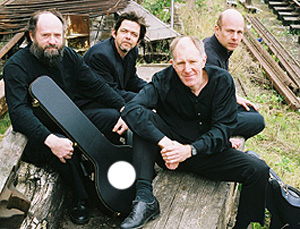
In this series of interviews, we talk to renowned Mandolin players, makers and enthusiasts.
Check out our comprehensive resource of Free Mandolin Tabs

Tell us a bit about the band?
The band is a quartet of 2 Mandolins, 1 Mandola (octave mandolin) and a Guitar. This is the classic quartet combination and enables us to play orchestral arrangements as well as arrangements for string quartet. We play small concerts, festivals and specialist evenings like Italian evenings for private functions.
How did the band get started?
It started from my passion for the Mandolin. I was looking for a format that I could use to present as wider range as possible of mandolin styles to the general public. Through concerts and a recording I wanted to share and spread the word that the mandolin is both a serious instrument and great fun to play.
Why the mandolin?
It is so versatile across so many styles. Our repertoire includes classical, folk, gypsy, ragtime, old standards and Brazilian Choro. I started out as a violin player. The mandolin has the same tuning as the violin GDAE and is similar in size so the transition was easy. I had to learn how to use a plectrum instead of a bow and that was the biggest learning curve, especially to learn how to play an even and expressive tremelo.
Musical influences.
My first influences were from the blues and jazz mandolin players from the 1920’s jug bands. I met blues singer and guitarist Dave Peabody in the late 60’s and we formed various bands together the most famous of which was “Tight LIke That”. I recorded several albums with Dave and later played on his solo albums.
I also did sessions for other artists on the folk and blues scene. My next big influence was the music of Dave Apollon the Russian gypsy, jazz player and entertainer who’s recorded works were collected and issued by David Grisman’s label. In the Early 90’s a punter in a restaurant I was playing at gave me a tape of the great Brazilian player Jacob do Bandolim. I was completely bowled over when I heard it and I started importing choro CD’s from Brazil.
Choro is kind of Jazz Samba style that evolved through traditional Brazilian and Portuguese music. The harmonies and melodic structures are brilliant. Also I am a big fan of classical mandolinist Alison Stephens and learnt a lot from attending her master class at Dartington summer school a few years ago.
Do you have any tips for learners?
Yes. Listen to mandolin albums and decide what you like to listen to. Find a good teacher. Keep an open mind. Find other people to learn with and play with. Have fun as you practice. Decide realistically how much time you can devote each day to playing and practicing.
Practice regularly a small amount rather than a few hours every now and then. Practice what you want to be able to play instead of what you already can. Go and see mandolin players play live in concert or pubs and clubs. Go and and introduce yourself, tell them you’re learning and ask them questions. They will be pleased to talk to you.
Do you think the status of the mandolin in popular music needs to be raised?
Yes. I formed mandolin express to do just this. I am also on the committee of the Banjo Mandolin and Guitar Federation (BMG) who are promoting the mandolin and mandolin courses. The only reference most people have is ice cream adverts and Rod Stuart’s ‘Maggie May’. I don’t think the film ‘Captain Correlli’s Mandolin’ did as much as it could.
Alison Stephen’s touring stage version was much better and was a great hit at the Edinburgh Festival. There are some great mandolin players around including Simon Mayor who does great work with young people in schools and courses promoting the celtic tradition. I am now running courses at the Bristol Folk House and have a growing number of private pupils. I also have a new quartet called ‘Brojeiro’ specialising in Brazilian Choro, very high energy with two mandolins, guitar and percussion.
What mandolins do you own?
My favourite is a custom mandolin built by luthier Phil Davidson. It is built on the style of a Brazilian model with a scaled down Maccaferri strutting. I also have a 1908 Gibson A1 which is great for blues and a 1947 Dobro resonator. I also have a beautiful classical bowl back 1963 Pasquale Pecoraro.
Apart from yourself who is your favorite player?
I don’t have a favorite because each player I like is unique in their own way and in their own style. I would like to list the players who I find inspiring, some living and some from the past. Dave Grisman, Butch Baldassari, Dave Apallon, Jacob do Bandolim, Rudy Cipolla. Alison Stephens, Howard Fry and Dave Swarbrick spring to mind and in no particular order.
If you deserted on an Island which three pieces of music would you care not to be without?
Oh this is hard. I assume you mean mandolin music. Number one would be ‘Quando me lembro’ played by Joel Noscimento from an album called’ Os Bambos do Bandolim’. Number two would be ‘Czardas’ played by Howard Fry from his album ‘Gypsy Mandolin’ and number three would be ‘Stardust’ played by Dave Apollon from ‘The Man with the Mandolin’ complete recordings 1930 – 1956′. If I could have just one more it would be ‘Concerto de Brandedenburgo No 3’ played by Orquestra de Cordas Brasileiras from their album of the same name.
If you had to start over again would you choose the Mandolin?
Yes, definitely.
Mandolin Interviews
Trevor Moyle Interview
Alon Sariel Interview
Dan Beimborn Interview
Kevin Macleod Interview
Dagger Gordon Interview
Alison Stephens Interview
Gary Peterson Interview
Ian Harris Interview
Allan Greenwood Interview
Stevie Interview
Marc Woodward Interview
Luke Plumb Interview
